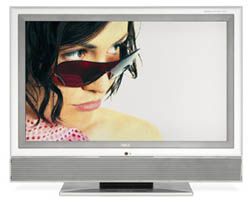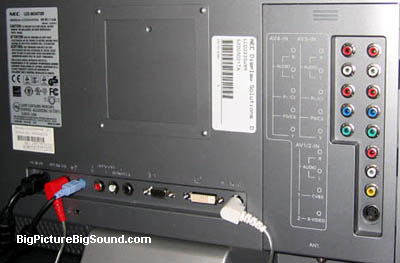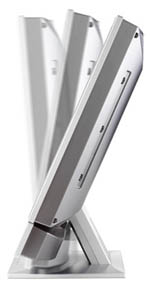NEC LCD2335WXM HDTV-enabled 23-inch LCD TV/Monitor Review
By Chris Boylan
A Versatile All-Around Performer
As regular readers may know, I have never been a huge fan of most LCD TVs, particularly in larger sizes. I've seen many over the years on bright trade show floors as well as in more controlled lighting conditions and they have usually left me cold. Less than perfect black levels, poor uniformity, motion trails and other digital nasties. Suffice it to say, early large-screen LCD panels never really floated my boat.
But they are sexy. Something about a light, thin, bright and detailed HDTV panel that can be hung on a wall is intriguing.
Smaller LCD screen sizes tend to exhibit less of the artifacts and problems of larger LCD screens. Also, the picture quality of LCD panels has continued to improve while the price has continued to drop, such that it's now possible to buy a 23-inch widescreen LCD TV with HDTV resolution for under $900. Enter the
NEC LCD2335WXM.

NEC's LCD2335WXM 23-inch Widescreen HDTV-enabled LCD TV. Babe not included.
When I first saw this NEC display at the Digital Life press preview in New York last year, it caught my attention. A bright detailed picture that looked good even up close. But would it hold up to detailed inspection in the Big Picture Big Sound labs? That is the question.
After unpacking the unit, I was impressed with its input flexibility. It includes two component video inputs, one DVI-D, one composite video, one S-Video and a standard 9-pin VGA computer input, plus a coax cable/antenna input for those who want to take advantage of the built-in NTSC tuner (the unit does not include an ATSC tuner). The TV also includes an audio input for its built-in powered speakers. These integrated speakers are perfectly acceptable for light computer use or casual TV watching, but home theater users will definitely want to let their audio system take care of the
Big Sound.

The NEC LCD TV features a plethora of inputs, including component video (2), composite video, S-Video, DVI-D and VGA, plus a cable/antenna input for the built-in NTSC tuner.
It's a PC Monitor. It's a TV. It's Both
I first tested the display as a PC monitor using the analog VGA input. The panel's native resolution (1280X768) makes it ideal for viewing web sites, digital photos and video content on the PC. Unfortunately my laptop's video card does not support a widescreen aspect mode, so I set the Windows display properties to 1024X768 resolution. This is still a direct match for the panel's resolution, so the image quality was exceptional, but it's like watching "regular" TV on a widescreen display -- it puts black bars on the sides of the screen.
Using the display's aspect resolution controls, I could stretch the image to fill the screen, but I chose accuracy over screen size and put up with the bars. It's important to note that this is
not a problem with the monitor itself but it could affect those whose video cards are similarly limited in their output resolution and aspect ratio. Many PCs today do include native support for widescreen monitors. And there are workarounds for those without native 16:9 support - if you use advanced video players such as the DIVX player, you can actually set a custom aspect ratio in the player, then use the NEC's aspect ratio control to expand the image to its proper geometry, using the entire width of the screen. I was able to view DVDs and AVI files on my PC in widescreen mode using this method.
Moving into the home theater, the monitor really stretched its legs. I tested the display using a number of different sources including a progressive scan DVD player (connected via component video), DirectTV satellite receiver connected via composite video and a Sony High Definition PVR (DHG-HDD500) connected via DVI, using an HDMI to DVI adapter.
The first thing I noticed about the NEC was that its brightness was set way too high. This isn't too different from other monitors whose default picture settings are configured to stand out on a bright retail showroom floor, not in the controlled lighting of a home theater or living room. Whipping out our trusty Avia calibration disc, I dropped the brightness down from 100 to 30, the contrast down from 50 to 25, and set the color temperature to "normal." This produced the most accurate color balance, and preserved detail, without whites getting too washed out or blacks getting too crushed. Blacks still aren't black, even with the contrast and brightness properly set - more like very dark gray - but in a dimly lit room, this was not too objectionable. Dynamic scenes like the Diva scene in
The Fifth Element maintained punch and impact.
Color reproduction was very good, with the Diva's skin just the right shade of blue, and Bruce Willis' skin tone a believable blend of olive and pink. I also observed that the TV has a fairly wide viewing angle (rated as 170 degrees), however dark areas of the screen do look much brighter (going from dark gray to a shade of blue) viewing the screen from well off-axis. The unit's rated 25 millisecond response time puts it behind the current crop of high-end LCD monitors, including newer monitors from NEC. This relative sluggishness reveals itself more in fast-paced gaming than in DVD/HDTV viewing, but fast-moving images do exhibit slight motion blur on this TV. Again, proper calibration of the monitor minimizes this artifact to the point where it is not too objectionable.

A removable stand (included) swivels to allow multiple viewing angles.
Playing around with the monitor's aspect ratio control from the component input, the "Panorama" mode (which zooms/stretches 4:3 content to fit the NEC's native 1.66:1 screen shape) exhibited some fuzziness in the edges where the stretching was happening. This was particularly noticeable when text appeared on the screen. If you keep the monitor in 4:3 mode for "normal" TV content and in 16:9 mode for widescreen content, then you won't see this fuzziness - proper geometry is maintained, and image detail is exceptional.
As good as DVDs looked on this monitor, particularly from a reasonable viewing distance of 6 to 8 feet, HDTV looked even better. High Definition movies, sports and TV shows such as
Medium and
Lost came across in vivid detail with life-like colors and nice depth of field. I did not notice a significant difference in image quality between the DVI and component video inputs so use whichever is more convenient to you. The DVI input is apparently not HDCP-compliant, so depending on your HD source and the flags set in the content, you might not see all content using the DVI input. This problem never reared its ugly head in my set-up, with the Sony HD DVR, but your mileage may vary. Fortunately the unit does have two sets of component video inputs so one way or another, you'll get your HDTV.
Toward the end of the review process, I performed an extremely unfair comparison of the NEC to our reference Loewe Aconda 38" tube HDTV. Using a 4 input/2 output component video switcher, I fed identical HD signals to both displays and noted the differences. While the tube monitor trounced the LCD display in areas of contrast and digital artifacts, the NEC held its own in the image detail and color accuracy departments, particularly considering its cost (1/5 the price of the Loewe).
Final Thoughts
All in all, I'd say the NEC is a strong performer in the medium-sized LCD TV category. Though it is not well-suited for gaming, due to its relatively slow response time, it equals or exceeds the performance of other similarly-sized LCD displays in most areas. Its flexibility of inputs, built-in speakers, computer display support, brightness and color accuracy make it a good choice for an all-around display device, particularly for a college dorm or small apartment where space is at a premium. I enjoyed my time with the LCD2335WXM and look forward to seeing what NEC comes up with next.
Specifications from the Manufacturer:
° 1280 x 768 viewing resolution
° Analog VGA and DVI-D PC inputs
° S-video, component, and composite video inputs
° Brightness: 500 cd/m
2
° Contrast: 500:1
° LCD panel response rate: 25 milliseconds
° One-year limited warranty
° Street price: $899
° Weight with stand: 22 pounds
° Dimensions (W x H x D):
° with stand: 22.8 x 18.4 x 8.3 in.
° without stand: 22.8 x 17.4 x 3.1 in.
Supported Resolutions:
° 720 x 400 @ 70.0 Hz
° 640 x 480 @ 60.0 Hz to 75.0 Hz
° 800 x 600 @ 56.0 Hz to 75.0 Hz
° 1024 x 768 @ 60.0 Hz to 75.0 Hz
° 1152 x 864 @ 60.0 Hz to 70.0 Hz
° 1280 x 768 @ 60.0 Hz to 70.0 Hz
(native panel resolution)
° 1280 x 960 @ 60.0 Hz to 70.0 Hz
° 1280 x 1024 @ 60.0 Hz to 70.0 Hz
Manufacturer's Contact Information:
NEC Display Solutions of America
500 Park Boulevard
Suite 1100
Itasca, IL 60143
Web site:
www.necdisplay.com
Phone: 1-800-632-4662


